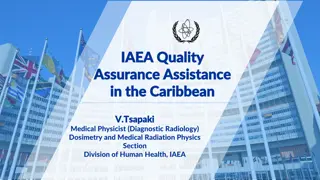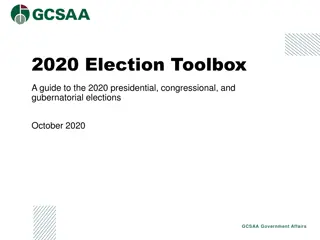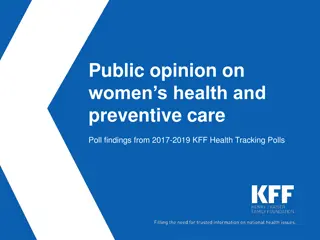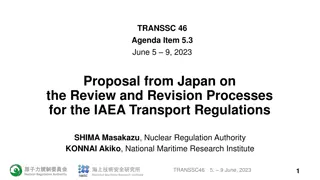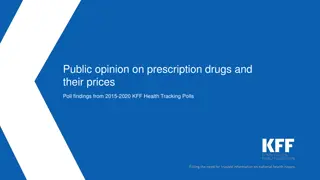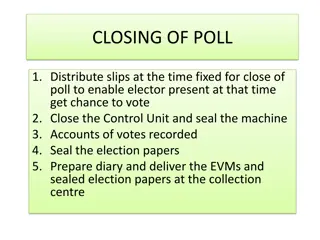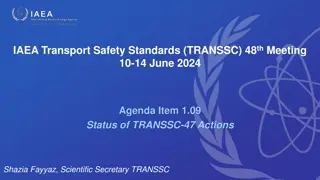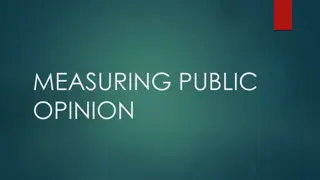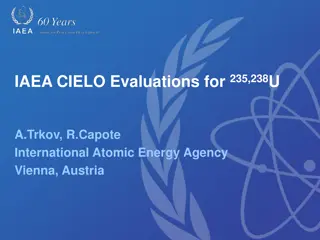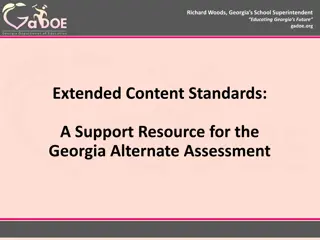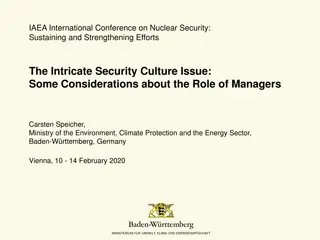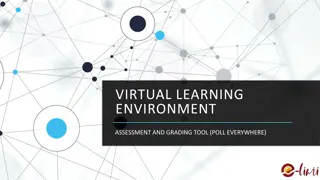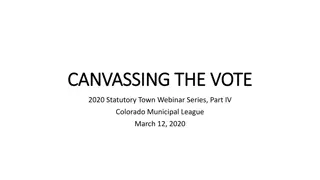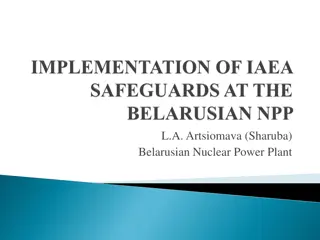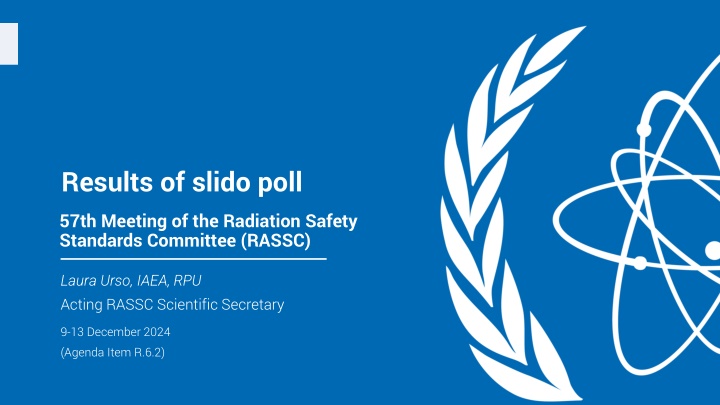
Radiation Safety Standards Committee Meeting Poll Results December 2024
Explore the results of a Slido poll conducted during the 57th Meeting of the Radiation Safety Standards Committee in December 2024. The poll addressed topics such as dose coefficients for intake, stakeholder consultation, adoption of ICRP Publications, challenges faced in implementing new software for dose calculations, and concerns related to the ICRP 103 series for workers based on inhalation and ingestion. Stakeholders highlighted issues with managing dose assessments for natural radionuclides in mining and industrial activities, addressing exposure risks in industries, and updating regulations to align with new dose coefficients.
Download Presentation

Please find below an Image/Link to download the presentation.
The content on the website is provided AS IS for your information and personal use only. It may not be sold, licensed, or shared on other websites without obtaining consent from the author. If you encounter any issues during the download, it is possible that the publisher has removed the file from their server.
You are allowed to download the files provided on this website for personal or commercial use, subject to the condition that they are used lawfully. All files are the property of their respective owners.
The content on the website is provided AS IS for your information and personal use only. It may not be sold, licensed, or shared on other websites without obtaining consent from the author.
E N D
Presentation Transcript
Results of slido poll 57th Meeting of the Radiation Safety Standards Committee (RASSC) Laura Urso, IAEA, RPU Acting RASSC Scientific Secretary 9-13 December 2024 (Agenda Item R.6.2)
1. public prescribed in legislation? In your MS, are dose coefficients for intake for workers and the
2. consulted when adopting dose coefficients for intake for workers and the public? In your MS, are stakeholders (public, licensees, duty holders, etc.)
3. dose coefficients for intake for workers? In your MS, which ICRP Publications are adopted as sources of
4. series for workers based on ICRP 103? Please also indicate if it is for inhalation or ingestion. (1) What challenges or concerns in your MS have been raised due to the OIR 1. New doses calculations software implementation ; Training of internal dosimetry service staff with NEW software; Calculation of derives air concentration and annual intake; Impact on selection respiratory protection system 2. Impact 3. revision of a large number of regulatory acts and guidelines 4. None so far 5. Impact; workplaces 6. RDC; Radon 7. None so far; Radon 8. None so far; Radon 9. Time consuming ; Change in ICRP does coefficient; difference in estimation dose has not regulatory significant 10. ICRP 103 is not adapted. 11. Impact 12. None so far
4. series for workers based on ICRP 103? Please also indicate if it is for inhalation or ingestion. (2) What challenges or concerns in your MS have been raised due to the OIR 13. Rn-222 ; Radon 14. None so far 15. Communication issues ; Adjustment of calculation tools; Communication; Adjustment of tools 16. Radon 17. Challenges due to the OIR series for workers based on ICRP 103 include: Inhalation: Managing dose assessments for natural radionuclides (e.g., radon and thorium) in mining and industrial activities. Ingestion: Addressing exposure risks in industries with potential contamination pathways. Efforts are focused on updating regulations, improving monitoring systems, and providing training to align with new dose coefficients." 18. UNSCEAR; Radon 19. smoothly; BSS 20. Radon 21. None so far
4. series for workers based on ICRP 103? Please also indicate if it is for inhalation or ingestion. (3) What challenges or concerns in your MS have been raised due to the OIR 22. Some relevant nuclides may have dropped.; Communication 23. Tourist caves (inhalation) 24. None so far 25. Radon for inhalation; actinide 26. Unknown 27. RnPinhalation and ingestion; Cost; Updating software; Training 28. New dose coefficients will be binding by regulation (the most important or often used will be listed and reference/link to the rest will be done) It concern relatively small group of workers, we do not expect significant impact on performing of practice leads to changes of licensing conditions. For radon, it has been already estimated, that lower tens of workplaces can exceed dose reference levels and therefore the activity performed would need to be treated properly (as like planned exp.sit.).; size
4. series for workers based on ICRP 103? Please also indicate if it is for inhalation or ingestion. (4) What challenges or concerns in your MS have been raised due to the OIR 29. UNSCEAR; Radon; Public; Smoking 30. The following issues have been identified and will be discussed among experts in the Radiation Council in FY2025, with the establishment of a subcommittee to study technical guidelines for evaluation methods for internal exposure. Selection of nuclides and chemical forms Treatment of nuclides whose chemical forms are to be reclassified Particle size Derivation process of airborne concentration limits 31. Monitoring frequency and follow up for temporary workers for further monitoring and dose assignment 32. Radon 33. None so far
5. to the forthcoming EIR series for members of the public that are based on ICRP 103? Please also indicate if it is for inhalation or ingestion. (1) What challenges in your MS do you foresee and/or have been raised due 2 1. Radon : reassessment of workers and public ; Discharges of effluents , repercussion of NEW values to public values unknown will require the revision of a large number of regulatory acts and guidelines None so far Communication; Economic impact ; ?; ?; Unknown yet Significant challenges; emergency; Discharges; Food; Medical; EPR modelling Time; no significant regulatory impact 10. ICRP 103 is not adapted. 11. None 12. Change in discharge limit and dose constraints; Discharge limits 2. 3. 4. 5. 6. 7. 8. 9.
5. to the forthcoming EIR series for members of the public that are based on ICRP 103? Please also indicate if it is for inhalation or ingestion. (2) What challenges in your MS do you foresee and/or have been raised due 2 13. None so far 14. Practices that already have discharge authorisation 15. Tool-adjustments 16. Still unclear 17. Monitoring Systems 18. Bss 19. BSS 20. None so far 21. None so far 22. Legal security 23. Release 24. None so far 25. exemption ; radon for inhalation 26. Un Known ; Unknown yet 27. None so far
5. to the forthcoming EIR series for members of the public that are based on ICRP 103? Please also indicate if it is for inhalation or ingestion. (3) What challenges in your MS do you foresee and/or have been raised due 2 28. New dose coefficients will be binding by regulation (the most important or often used will be listed and reference/link to the rest will be done) No significant challenges are expected, no changes in regulation requirements or emergency planning system (such as establishing emergency planning zone) are foreseen. 29. Fear of change; UNSCEAR; Radon; EPZ 30. The following issues have been identified and will be discussed among experts in the Radiation Council in FY2025, with the establishment of a subcommittee to study technical guidelines for evaluation methods for internal exposure.; Selection of nuclides and chemical forms,; Treatment of nuclides whose chemical forms are to be reclassified,; Particle size,; Process for deriving exhaust or airborne concentration limits,; Process for deriving concentration limits in effluent or wastewater.; Simultaneous incorporation of EIR and OIR series 31. Public dose calculation with dose coefficients, if revisited, may cause changes in dose constraint for facility and overall site dose constraint 32. Unknown yet



